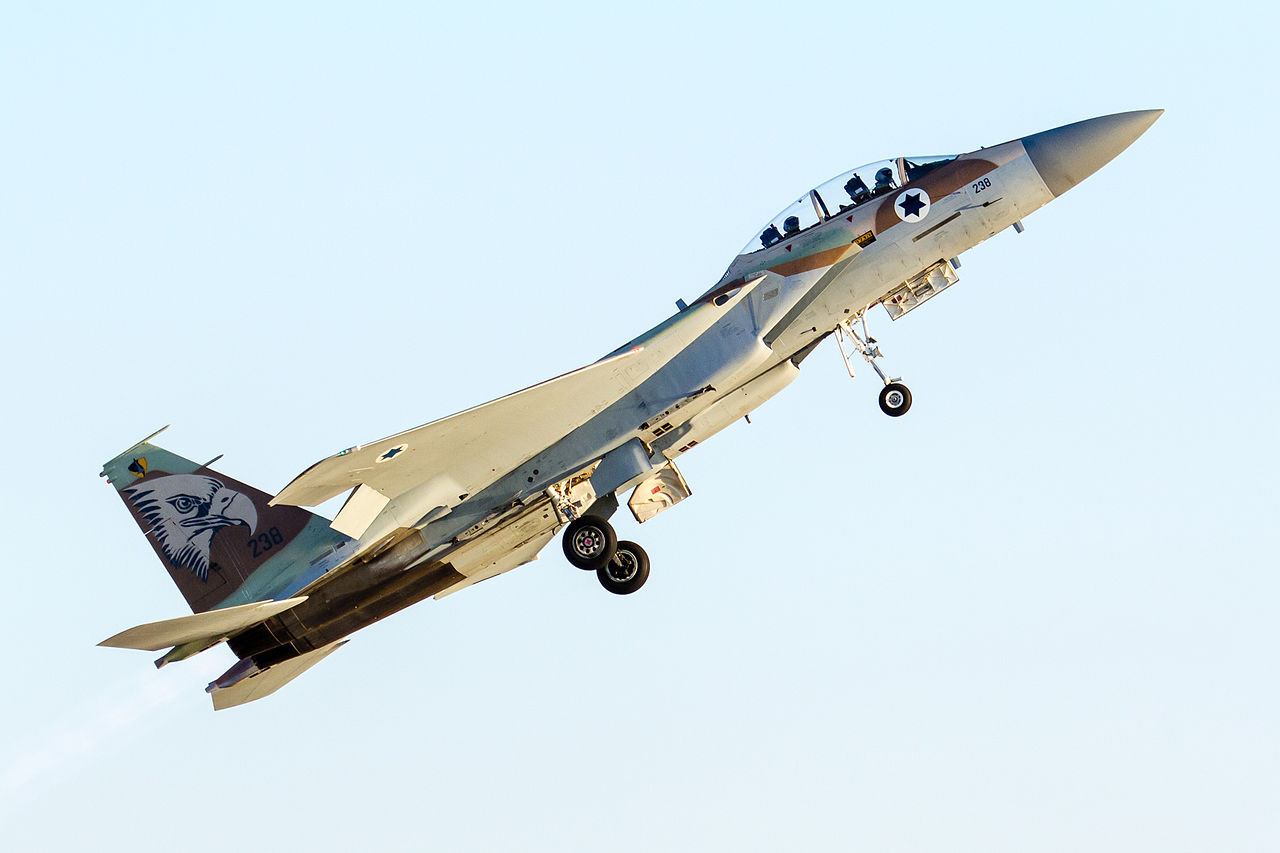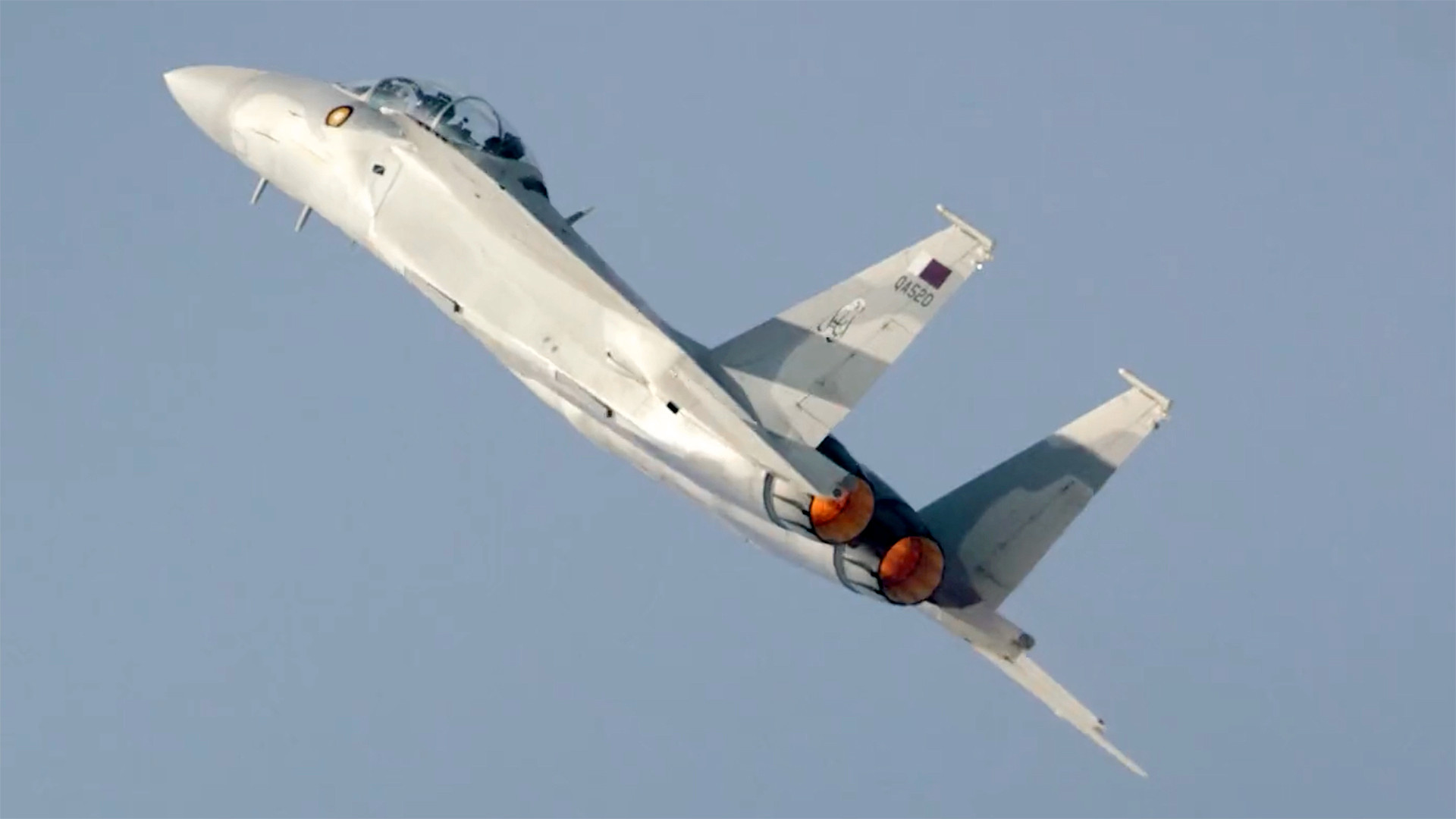Qatar’s F-15QA Advanced Eagle has made its formal public debut in style this week. Unburdened by any stores, without its conformal fuel tanks, and with the help of its advanced fly-by-wire technology and its pair of powerful F110-GE-129 engines, the big jet has been wowing the crowds at the Dubai Airshow in the United Arab Emirates.
Check out the F-15QA demo for yourself:

Jason “Mongoose” Dotter, an F-15 experimental test pilot, and Mike “Houdini” Quintini, an F-15 flight test weapon systems operator, both of whom are employed by the jet’s manufacturer Boeing, have been in the front and back seats for the demos in Dubai. The Qatari Emiri Air Force currently has a fleet of 36 F-15QAs, the aircraft being locally nicknamed Ababil — understood here to mean ‘peregrine falcon,’ but a word that is also often frequently translated into English as ‘swallow.’ The announcement that the last five examples had been delivered came just in August. You can read much more about this impressive fighter in our previous deep dive on the F-15QA.

Qatar’s F-15QA is derived from the F-15SA Advanced Eagle for Saudi Arabia and subsequently served as the basis for the F-15EX Eagle II for the U.S. Air Force. It is the most advanced variant of the F-15 flying operationally in the world today.
The F-15QA is the second in the Eagle family to feature a fly-by-wire system, which was first included on the F-15SA. What this means at its most basic level is that when the pilot moves the stick or rudder pedals, a computer processes the inputs and then tells the plane’s control surfaces what to do. This is a huge capability advancement that helps optimize performance in most flight regimes and provides added margins of safety, allowing pilots to push the jet to its limit with fewer risks. It allows for the kind of flying that has been on display in Dubai, which would not be possible — at least without major risk — with older versions of the F-15 that use a hybrid traditional hydro-mechanical control system paired with a Control Augmentation System (CAS). CAS provided automatic fine-tuning and filtering for the Eagle’s flight control system, but was a far cry from a fully digital fly-by-wire setup.
Qatar’s F-15QAs have other improvements over older Eagles, including a new low-profile heads-up display (HUD) and a single digital multi-functional large area display underneath, as can be seen in the screen grab from a Boeing promotional video below.

The F-15QA has been seen flying on many occasions since the type first took to the skies with an extremely high-angle “Viking takeoff” at full afterburner back in 2020. Still, the routine performed at the Dubai Airshow has been more intense than anything seen from this version of the F-15 in the past.
The display routine the F-15QA has been flying in Dubai includes “a tailslide, abrupt pulls, and extreme high-alpha flying,” according to a social media post from the This is Flight airshow e-magazine, which also posted the video of the demo seen at the top of this article.
“Normally you would expect an aircraft to slow down as it goes into the vertical, but as you can see, it’s [the F-15QA] gone straight up, it’s maintained the same power all the way through [the loop],” a narrator at the Dubai Air Show can be heard explaining in the clip below. That same individual notes that the F-15QA is rated to handle forces of up to nine Gs while maneuvering, but that the flight systems can be set to allow for up to 12 Gs in an “emergency.”

When asked by AEROSPACE magazine what the angle of attack (AoA) limit is on the F-15QA (or EX), Boeing test pilot Matt Giese simply said: “There isn’t one.”
This all speaks to the aircraft’s advanced fly-by-wire system, as well as the power offered by its two General Electric F110-GE-129 turbofans. At full afterburner, each -129 can produce nearly 30,000 pounds of thrust.

Steve Trimble, Aviation Week‘s Defense Editor, got more inside details about the F-15QA’s routine in Dubai from an interview with Jason “Mongoose” Dotter. Talking alongside Guy Norris and Tony Osborne, Aviation Week‘s Senior Editor, and London Bureau Chief/European Defense Editor, respectively, on the latest edition of the Check 6 podcast, Trimble explained:
“I mean, he really put the airplane through its paces to show what you can do with an F-15 with a flight control system that is digitally, and artificially limited to let you get as much performance as possible out of that jet without causing any real safety issues, as long as you don’t do anything too crazy. I mean, everything stayed within the box, a very, very tight box above the runway. There was no zipping up and down the runway, or zipping out of the airspace, and coming back in.”
…
“…to regain energy, and come back, and set up and do something else. No, he stayed in this very tight box doing low-speed maneuvers, trying to show the combat relevance in low-speed situations of what that jet can do now with that fly-by-wire. And I mean, the kinds of things he was talking to me about was, how in testing, they just can’t make the jet now go out of control. They’ve loaded up the wing, just one wing, but not the other.”
…
“An asymmetric load, and then applied opposite rudder, and crossed the controls all at the same time, and they still can’t make the jet depart from controlled flight. So, there’s a lot more they can do with that jet now, and so you could see it do, it did kind of a… As he told me, I never saw it, but it was supposed to do kind of a headstand, and then a J-turn, a kind of a J-turn, which is normally associated with super-maneuverable thrust-vectoring fighters like the F-22, or Su-35, Su-57, but the F-15 doesn’t have thrust vectoring. But by tricking the control surfaces, using that fly-by-wire logic, and the pilot just applying as much yaw as he can, in this case, you can get the effect of a J turn without that thrust-vectoring assistance to do it.”
Osborne also highlighted that this year’s Dubai Airshow “is the first time that we’ve seen the fly-by-wire F-15 really put through its paces.” The Saudi F-15SA and the Air Force’s F-15EX have this same capability, but neither has been publicly flown in this manner. Osborne further noted that this was clearly a choreographed routine meant to show off the extremes of the F-15QA’s performance. This is, of course, typical of what is seen at airshows, especially when it comes to fighters.
There are some very broad similarities between what has been seen in Dubai and the old routine that the Air Force’s now-defunct F-15C demo team used to fly.
“One of the coolest parts of the F-15C demo was the takeoff, with the pilot performing a hard stick-back, high angle of attack rotation,” The War Zone‘s own Tyler Rogoway wrote years ago in a piece for Jalopnik. “The rest of [the] show consisted of minimum radius turns, zoom climbs, crisp rolls, and dirty passes.”

However, as has already been made clear, the two-seat F-15QA, and other Advanced Eagles, are far more powerful and capable overall than the single-seat F-15C. Those 1970s to mid 1980s-era Eagles have no fly-by-wire capability and are powered by Pratt & Whitney F100-PW-220 turbofans each producing a maximum of just under 24,000 pounds of thrust. The F-15A/C is, of course, lighter and, for the most part, more maneuverable than the Strike Eagle variants that followed.
Demonstrations involving variations of the F-15E Strike Eagle, from which the Advanced Eagle subvariants evolved, in ‘clean’ configurations without stores or conformal fuel tanks are not unheard of, either. Israel has put on such performances with its F-15I Ra’am jets in the past. Those aircraft still do not benefit from the fly-by-wire system and other improvements found on the F-15QA.

Altogether, the F-15QA’s display in Dubai is really unlike anything that has been seen from an F-15 variant before. Maybe the U.S. Air Force will put together a new F-15EX demo team and this will become a more common sight at airshows in the future.
Contact the author: joe@thedrive.com
